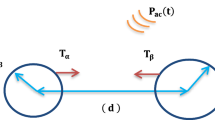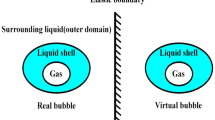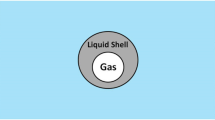Abstract
The nonlinear behavior of bubble in the blood vessel restricts the applications of bubble technology in the cardiology. In this paper, a novel engineering solution is proposed to control the radius of the bubble and prevent bubble collapse. For this purpose, the nonlinear dynamics of the bubble in the blood vessel is introduced and then presented into the state-space form. The next part of this paper is devoted to designing a nonlinear control method, where the ultrasonic wave plays the role of control input and the output is the radius of the bubble in the blood vessel. In order to achieve faster, finite-time convergence and higher control precision, fast terminal sliding mode is proposed. The stability of the closed-loop system is ensured through the Lyapunov stability analysis. In order to tackle the chattering problem, the switching gain is adaptively tuned according to the fuzzy rule. In this method, the tracking error and its differential are considered as the inputs and the switching gain is considered as the output of the fuzzy logic system. Simulation results confirm the effectiveness of the proposed control method. Finally, the results of this research are of immediate interest for modern medical applications such as ultrasonic imaging, targeted drug delivery, and cancer treatment.


















Similar content being viewed by others
References
Doinikov AA et al (2013) Encapsulated bubble dynamics in imaging and therapy. In: Delale C (ed) Bubble dynamics and shock waves. Springer, Berlin, pp 259–289
Pulsipher KW et al (2018) Engineering theranostic microbubbles using microfluidics for ultrasound imaging and therapy: a review. Ultrasound Med Biol 44(12):2441–2460
Wang D et al (2018) Bubble-echo based deconvolution of contrast-enhanced ultrasound imaging: simulation and experimental validations. Med Phys 45(9):4094–4103
Das D et al (2018) Microfluidics-based microbubbles in methylene blue solution for photoacoustic and ultrasound imaging. In: Photons plus ultrasound: imaging and sensing 2018, International Society for Optics and Photonics
Lohse D (2018) Bubble puzzles: from fundamentals to applications. Phys Rev Fluids 3(11):110504
Wiedemair W et al (2012) On ultrasound-induced microbubble oscillation in a capillary blood vessel and its implications for the blood–brain barrier. Phys Med Biol 57(4):1019
Aryal M et al (2014) Ultrasound-mediated blood–brain barrier disruption for targeted drug delivery in the central nervous system. Adv Drug Deliv Rev 72:94–109
O’Reilly MA, Hynynen K (2018) Ultrasound and microbubble-mediated blood–brain barrier disruption for targeted delivery of therapeutics to the brain. Methods Mol Biol 1831:111–119
Zandi A et al (2019) Microneedle-based generation of microbubbles in cancer tumors to improve ultrasound-assisted drug delivery. Adv Healthc Mater 8(17):1900613
Brett JM, Krelle A (2018) A study of bubble collapse pressure pulse waves from small scale underwater explosions near the water surface. J Sound Vib 435:91–103
Phan T-H, Ha C-T, Park W-G (2018) Numerical simulation of bubble collapse between two parallel walls and saturated film boiling on a sphere. Int J Heat Mass Transf 127:116–125
Ohashi M, Ichihara M, Toramaru A (2018) Bubble deformation in magma under transient flow conditions. J Volcanol Geotherm Res 364:59–75
Garbin V (2019) Collapse mechanisms and extreme deformation of particle-laden interfaces. Curr Opin Colloid Interface Sci 39:202–211
Guo B, Chen Y (2019) Adaptive fast sliding mode fault tolerant control integrated with disturbance observer for spacecraft attitude stabilization system. ISA Trans 94:1–9
Wang Y, Hou M (2019) Model-free adaptive integral terminal sliding mode predictive control for a class of discrete-time nonlinear systems. ISA Trans 93:209–217
Li S, Zhou M, Yu X (2012) Design and implementation of terminal sliding mode control method for PMSM speed regulation system. IEEE Trans Ind Inf 9(4):1879–1891
Vincent O et al (2014) The fast dynamics of cavitation bubbles within water confined in elastic solids. Soft Matter 10(10):1455–1461
Mobayen S, Baleanu D, Tchier F (2017) Second-order fast terminal sliding mode control design based on LMI for a class of non-linear uncertain systems and its application to chaotic systems. J Vib Control 23(18):2912–2925
Ma H, Wu J, Xiong Z (2016) Discrete-time sliding-mode control with improved quasi-sliding-mode domain. IEEE Trans Ind Electron 63(10):6292–6304
Edwards C, Shtessel Y (2019) Enhanced continuous higher order sliding mode control with adaptation. J Frankl Inst 356(9):4773–4784
Rahmani M, Ghanbari A, Ettefagh MM (2018) A novel adaptive neural network integral sliding-mode control of a biped robot using bat algorithm. J Vib Control 24(10):2045–2060
Yen VT, Nan WY, Van Cuong P (2018) Recurrent fuzzy wavelet neural networks based on robust adaptive sliding mode control for industrial robot manipulators. Neural Comput Appl 31:6945–6958
Zhou C et al (2018) Optimal sliding mode control for an active suspension system based on a genetic algorithm. Algorithms 11(12):205
Farahmandrad M et al (2019) Design of higher-order sliding mode controller based on genetic algorithm for a cooperative robotic system. Int J Dyn Control 8:269–277
Doinikov AA, Aired L, Bouakaz A (2011) Dynamics of a contrast agent microbubble attached to an elastic wall. IEEE Trans Med Imaging 31(3):654–662
Doinikov AA, Zhao S, Dayton PA (2009) Modeling of the acoustic response from contrast agent microbubbles near a rigid wall. Ultrasonics 49(2):195–201
Garashchuk IR et al (2019) Hyperchaos and multistability in nonlinear dynamics of two interacting microbubble contrast agents. arXiv:1903.03955
Doinikov AA (2004) Mathematical model for collective bubble dynamics in strong ultrasound fields. J Acoust Soc Am 116(2):821–827
Doinikov AA, Manasseh R, Ooi A (2005) Time delays in coupled multibubble systems (L). J Acoust Soc Am 117(1):47–50
Doinikov AA et al (2019) Nonlinear dynamics of two coupled bubbles oscillating inside a liquid-filled cavity surrounded by an elastic medium. Phys Rev E 99(5):053106
Najafi M et al (2016) Approximate analytical solution via ADM and numerical simulation of acoustic cavitation: bubble dynamics. In: Miller R, Liggeri L (eds) Progress in colloid and interface science. CRC; Taylor & Francis, Boca Raton, pp 413–430
Hegedűs F, Kalmár C (2018) Dynamic stabilization of an asymmetric nonlinear bubble oscillator. Nonlinear Dyn 94(1):307–324
Haghi H, Sojahrood A, Kolios MC (2019) Collective nonlinear behavior of interacting polydisperse microbubble clusters. Ultrason Sonochem 58:104708
Dollet B, Marmottant P, Garbin V (2019) Bubble dynamics in soft and biological matter. Annu Rev Fluid Mech 51:331–355
Martynov S, Stride E, Saffari N (2009) The natural frequencies of microbubble oscillation in elastic vessels. J Acoust Soc Am 126(6):2963–2972
Sassaroli E, Hynynen K (2005) Resonance frequency of microbubbles in small blood vessels: a numerical study. Phys Med Biol 50(22):5293
Chahine GL, Hsiao C-T (2012) Modeling microbubble dynamics in biomedical applications. J Hydrodyn Ser B 24(2):169–183
Badfar E, Ardestani MA (2019) Utilizing sliding mode control for the cavitation phenomenon and using the obtaining result in modern medicine. SN Appl Sci 1(11):1419
Badfar E, Ardestani MA, Beheshti MT (2020) Robust nonsingular terminal sliding mode control of radius for a bubble between two elastic walls. J Control Autom Electr Syst 31:283–293
Badfar E, Ardestani MA (2019) Robust versus optimal control for the radius of spherical bubble in a perfect incompressible liquid, LMI optimization approach. Int J Dyn Control 8:497–507
Doinikov A, Novell A, Bouakaz A (2012) Dynamics of a contrast microbubble between two elastic walls. In: 2012 IEEE international ultrasonics symposium, IEEE
Doinikov AA, Bouakaz A (2013) Ultrasonically induced dynamics of a contrast agent microbubble between two parallel elastic walls. Phys Med Biol 58(19):6797
Böhm L, Brehmer M, Kraume M (2016) Comparison of the single bubble ascent in a Newtonian and a non-Newtonian liquid: a phenomenological PIV study. Chem Ing Tec 88(1–2):93–106
Liu L et al (2016) Experimental studies on the terminal velocity of air bubbles in water and glycerol aqueous solution. Exp Therm Fluid Sci 78:254–265
Azmin M et al (2012) How do microbubbles and ultrasound interact? Basic physical, dynamic and engineering principles. Curr Pharm Des 18(15):2118–2134
Abe Y, Kawaji M, Watanabe T (2002) Study on the bubble motion control by ultrasonic wave. Exp Therm Fluid Sci 26(6–7):817–826
Author information
Authors and Affiliations
Corresponding author
Appendix: Proof of Lemma 1
Appendix: Proof of Lemma 1
When the system states reach nonlinear sliding surface, the following equation is hold
Equation (30) can be formulated as
Let \( \alpha = e^{{\left( {1 - \frac{q}{p}} \right)}} \), then Eq. (31) can be rewritten as
The solution of differential Eq. (32) is obtained as follows
Take the logarithm of Eq. (33) yields
With the help of \( \alpha \left( 0 \right) = \left( {e_{0} } \right)^{{\left( {1 - \frac{q}{p}} \right)}} \), the following result is obtained
Rights and permissions
About this article
Cite this article
Badfar, E., Ardestani, M.A. Design of adaptive fuzzy gain scheduling fast terminal sliding mode to control the radius of bubble in the blood vessel with application in cardiology. Int. J. Dynam. Control 9, 199–210 (2021). https://doi.org/10.1007/s40435-020-00641-y
Received:
Revised:
Accepted:
Published:
Issue Date:
DOI: https://doi.org/10.1007/s40435-020-00641-y




